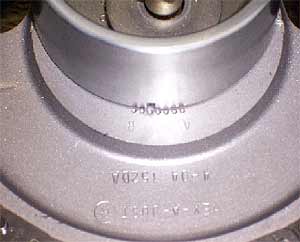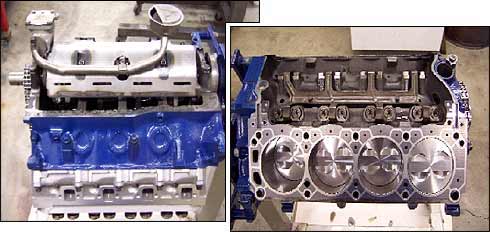|


This is attempting
to show the degree notches that are used
for advancing or retarding the cam timing.
Instead of removing the crank sprocket or
using small offset bushings you simply rotate
the eccentric to the desired position. NICE!
|
The last thing I want to touch on is valve
clearance. Not having enough can be very bad!
I simply cannot emphasize enough the importance
of checking valve clearance. Once you have the
cam put in its place, assemble a cylinder head
with light checking springs on one chamber and
install it with an old gasket of the same approximate
thickness as the ones you will use. Drop in
the pushrods and rocker arms you will be using
and set a dial indicator up to read the travel
of the valve retainer. Now rotate the engine
over carefully and with your hand gently push
down on the rocker arm tip where it contacts
the valve stem. Doing this at different points
along the way you will find the point of closest
clearance and know what you have. The correct
amount depends on many variables so a call to
a reputable engine builder or cam company would
be wise. The generally accepted clearance would
be .080" minimum. I have some engines running
with only .035" clearance but that is not normally
desired. It's a rules thing. The design of your
valve springs and installed seat pressure can
also have dramatic effects on performance, especially
when the valve clearances become tighter. I
helped a customer with a BBC last year pick
up .15 seconds and almost three mph simply by
increasing spring pressure. Once again, there
is no one perfect pressure for every combination.
It is a matter of trial and error, but I always
lean towards what some people would call the
"over-sprung" end of the spectrum. I have not
seen an example yet where too much spring made
less power. Unless of course you have a flat
tappet cam and wipe the lobes off! Ha, ha!

Here we see the bottom
end with windage tray/scraper and the factory
Ford oil pump and pickup tube. CUTLINE: This
is attempting to show the "spider" tray that
keeps the hyd.roller lifters in place. Also,
the Ford Performance head gasket.
Well, the pictures will tell the rest of the
story and I am REALLY looking forward to finally
getting back on the track! Not racing just plain
SUCKS! Next issue I will cover the fuel and
ignition systems along with intake manifold
selection and hopefully have some actual track
results!
Remember, life's too short.
When in doubt, DO A WHEELIE!! 
|